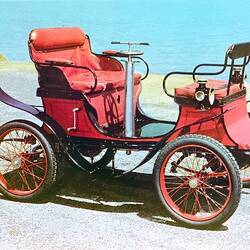Summary
The firm De Dion, Bouton et Trepardoux was formed in Paris 1883 to produce steam vehicles, especially steam-powered cycles. Count Albert De Dion became interested in internal combustion in the early 1890s which led to a split with his brother-in-law Trepardoux and the formation of De Dion, Bouton et Cie in 1894. The firm's 1895 model 137 c.c air-cooled engine was used by other manufacturers of small motor vehicles known in France as 'voiturettes'. By 1899, De Dion, Bouton's own voiturette was in production with a high revving, 402 c.c engine mounted at the rear. The vehicle featured a beam axle and suspension system of advanced design. No reverse gear was fitted and steering was by a vertical tiller type control with driver and passengers facing each other. By 1902, a more conventional front-engine, steering wheel equipped De Dion, Bouton model was in production. Up to the start of the First World War in 1914, De Dion, Bouton were one of the most successful French automotive manufacturers with an extensive product range and considerable export sales success. The company produced commercial vehicles and cars between 1918 and 1950 but never recovered its pre-1914 success. Henry Royce (of Rolls-Royce) purchased a De Dion voiturette as his first motor car on the advice of his doctor as a means of relaxation from overwork.
The Museum's engine is a single-cylinder petrol unit (3.5 H.P). It was made around 1900 by De Dion, Bouton et Cie in Paris and was donated in 1936 by Mr F.J. Garton. It has been sectioned for display purposes.
More Information
-
Collecting Areas
-
Acquisition Information
Donation from F. J. Garton, 23 Jul 1936
-
User (Probable)
F. J. Garton, Melbourne, Greater Melbourne, Victoria, Australia
-
Classification
-
Category
-
Discipline
-
Type of item
-
Overall Dimensions
390 mm (Length), 230 mm (Width), 570 mm (Height)
-
Keywords
